#i recommend the manga more
Explore tagged Tumblr posts
Text

READ/ WATCH HELCK
#fanart#myart#digital fanart#helck#helck anime#Vamirio#Vermilio#vamirio helck#Helck manga#i love them#i recommend the manga more#good non-isekai fantasy story
40 notes
·
View notes
Text

It's crazy how Dungeon Meshi's manga can feel more cinematic and emotional than the anime to me, even when they're practically the same. Compared to the anime, this moment is such a heartbreaking gut-drop. The way Kui uses negative space and flat compositions to create a sense of horrific stillness is so key.
The way the text (Senshi's monologue) is sequestered to an empty corner of a panel or huddled away from the edge of its text box is not only a great way of showing Senshi's headspace (fearful, isolated, dissociating), but creates a visual representation of pause, as if you hold your breathe after each line. The first panel puts us directly in Senshi's perspective too (compared to in the anime, which puts us as an outside observer over Senshi's shoulder). The detail of the door and bricks so effectively implies that he stared at it for so long, waiting and hoping, that its image is burned in his memory. The wood grain, the brick arch, the number of rivets. The lack of dialogue in the second panel shows a moment of realization too –– "he's dead" (also a great example of the Kuleshov effect). And it's that pause that creates a beat and sets a great rhythm to his headspace, like a music rest: "He never came back." (oh god.) "I'm all alone." Finally, the third panel's negative space, cropping Senshi, shows how truly alone he feels. Without his family, the world ceases to exists. Under shock, he traps himself in a 1-foot radius, too scared to even perceive a world outside its boundaries; a world that can hurt him, kill him, make him disappear with it. There is only his body, the stone beneath his feet and against his back, his thoughts, and that awful bowl of soup.
Even though they're a series of flat images, there's an implicit reading of silence in Senshi's realization and horror. Kui influences your experience to slow down and take your time.
Compare this to the anime, which fills every shot with dialogue. The pacing is fast; we never get to sit in silence like we do with the manga. The horizontal frame allowed the boarders to add Senshi, turning the composition into an over-the-shoulder shot, which takes us out of Senshi's POV. They also added a zoom-out in shot one, which adds unnecessary energy to a very somber scene. The tightening on Senshi as a close-up reaction shot also dulls the moment. In the original panel, Senshi stares ahead at the empty space to his left as a shadow surrounds his mind. It not only shows how Senshi's senses are dulling and his world is shrinking (setting up panel three), but shows how terrified Senshi is of what's in front of him, how the air itself becomes pitch black and opaque, how Senshi is surrendering himself to fear. The pacing is understandable and necessary; this episode packed a lot of story content together. It's just a shame because it really (imo) deflated one of the most nauseating moments in Dungeon Meshi.
#dungeon meshi#senshi#analysis#personal#long post#not art#because comics are inherently more abstract and rule-breaky the format thrives off show don't tell#i think trigger is doing a great job overall but they missed the mark on this scene#for me cinematic storytelling will prioritize rhythm; tension; and silence over plot. that's why the manga feels more “cinematic”#if you've been enjoying the anime i cannot recommend also reading the manga enough. it's a completely different experience with much more#subtext and emotion to draw from
4K notes
·
View notes
Text
Sometimes u think something has a big fandom and then u find out theres like 5 people in it and ur mutual is just REALLY into it
#This is about yohaji#Theres only like 6 of us#Hopefully we get some more ppl with the anime#But i said the same thing about fukigen na mononokean#yohaji#youkai gakkou no sensei hajimemashita#fukigen na mononokean#Fukimono#Ummm#Oh#jeweler richard#Jr#Damn what is that manga called#Pleasant nobles vacation plans#Or something ill check#A gentle noble's vacation recommendation#Oofuri#Sorry oofuri heads i love yall
453 notes
·
View notes
Text

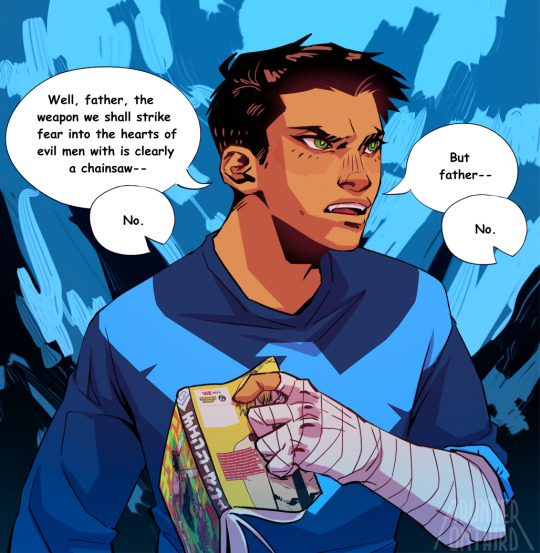
okay fine i can deal with damian being a weeb but he'll be one on MY TERMS
#boys gonna have TASTE or so GOD HELP ME#if u dont know that manga hes holding is chainsaw man#its REALLY good and i deeply recommend it#in terms of writing its a 10 in terms of emotional damage its ripping ur heart out and spitting on it#damian wayne#robin#batman#dc comics#my art#im such a fucking annoying weeb dude i was gonna put the cover on the right so it showed more but nooooo#my brain went BUT MANGAS ARE THE OTHER WAY AROUND i hate everything#ladies. gentlemen. you have eaten well.
3K notes
·
View notes
Text

guys i started reading this recently and let me tell you. You have to read this one.... ITS SO GODDAMN FUNNY. im having the time of my life... wholeheartedly rec
#the comedic timing really hits unlike a lot of comedy webtoons that miss the mark for me...#but not only that but it's genuinely a rly solid story w a likeable cast??#it genuinely has a lot of heart and the emotional beats hit (i cried)...#im up to ep 62 now#it balances comedy action and heartwarming well...#its been a long time since ive read such a genuinely good gag manga like this#tbh i didn't have much expectations going in but u see that 9.9 rating... i understand why it's so high now fkdhdj#deserved tbh#webtoon recommendation#the greatest estate developer#tged#talk tag#cant wait to read more whenever i have downtime#ok im going to wait a bit to rb fanart
159 notes
·
View notes
Text
when the media has themes of food and/or hunger

#yapping#one of my favorite things#delicious in dungeon#redesign your logo#<- specifically the line “color makes us hungry / hunger makes us human”#mouthwashing#fear and hunger#little nightmares#nbc hannibal#just themes of like. malicious eating. idk something about it#tokyo ghoul#thats all i can think of rn but there are more#if you have recommendations tell meeeeee :3#madk manga#yellowjackets#the menu#i keep thinking of more
302 notes
·
View notes
Note
Hi! Sorry if you've been asked this before (or just don't want to say, because that's cool too), but I was wondering if you had any book or author recommendations you could give? :> Your art is always accompanied by such lyrical captions, and I was wondering what inspired them. Thank you for your time and all the gorgeous art you share! <3
Thank you so much!!
I just love creating little stories with each picture when i paint them! (Btw big thanks to my wife for helping me spellchecking and beta reading those since english is not my first language!)
For recs, a lot of the inspiration from fairytale books I read as a kid and some more recent influences but its really a little bit everywhere so its hard to pinpoint!
But heres a few of my favourites for this october mood!
The last Unicorn

Anything by emily caroll!

Tove Jansson

T kingfisher

The angels game by Carlos Ruiz Záfon

Hope you find one you like!:D
#i tried to give a variety of recommendation!#i could add even more!#and def give some of the more obscure a try!#havent read angels game in year but it was that perfect dreamy/haunted 1920s vibe i loved#the manga “even monsters like fairytales” too could go#and “La mort d'arthur” for a VERY classic lit read#book recs
202 notes
·
View notes
Text
can i just say. and this is probably a niche hill to die on. that i am so gobsmacked every time someone vaguely hints at the idea that jotaro doesn't care meaningfully for the other crusaders, usually particularly kakyoin and joseph, when those two actually tend to be the ones he reacts to being hurt the hardest







like he cares for his loved ones!!!! that literally plays into his character motives in every single part he shows up in!!! stop lying to me!!!!!!!
#me.txt#jjba#i'm going to ramble in tags actually. excuse me#ok. rereading sdc and so confused at the general perception of jotaro and his friends/family. he's not NEARLY as flat or as dickish#i understand that the anime (particularly the dub) tends to slander him but even then he still clearly cares for them! i'm confused#i also understand that a lot of people dig against jotaro and kakyoin as a dynamic because 'they're popular' and that generally disliking#popular things across media is a thing that i've seen consistently everywhere but the discredit to them simply as a DUO and not even as a#pairing is so..... odd..... like they're considered to be a duo that clicks for a reason. i enjoyed them even before i got into the fandom#every time i see someone say jotaro is overrated/dull i take a shot and assume they're an anime-only or only read the manga like once btw#joseph and jotaro also have a neat dynamic and they obviously both love and care for each other. like they're not going to go around loudly#or anything but literally the entirety of the lovers and the prelude to the dio fight IS jotaro being worked up over joseph getting hurt#equally i don't know if it translates to the anime as much but joseph is VERY complimentary when it comes to jotaro. like he sings his#praises so often and reminds everyone that he's his grandson so frequently (d'arby the gamer is a good example of this). either way it's so#peculiar....... there's not enough avdol and jotaro content btw (also in canon) because jotaro obviously looks up to him and avdol jokes#around with him on the occasion they interact after their intro which doesn't start very well. it's very cute#i do think an important thing to note about jotaro's character is how he acts AFTER his intro because he's so drastically different. early#jotaro and later jotaro aren't the same character and i do not mean this in a character development way. excluding the jail incident he's#completely different and probably shouldn't really be taken into account (especially considering the amount of slapstick in araki's intros)#and i think that's really???? what people center on for his character? Which sucks balls bad!#anyways. i could ramble more about this if asked i have so much to say but sigh. jotaro cares so much for his friends and family he's not a#flat fully cold asshole character regardless of whether you watch the anime or ova or read the manga. you just have poor media literacy#i wouldn't recommend watching solely the anime for his character though. the dub also changes a lot so it's... questionable#i love the anime and it's still important for him though. also adds neat stuff. i need to stop myself. i have many thoughts on the matter#jotaro kujo#joseph joestar#noriaki kakyoin#adding in case anyone sees: i am not saying that he is perfect about this. in fact he is very ass about it with jolyne and holly and that's#very important. he also is in fact an asshole sometimes. NOT as much as you guys are making him though!#please don't get me started on how much of a dick etc people make kakyoin to veer away from the 'woobified' characterizations of him#in fact i think that's bad if not worse because it CLAIMS to be in character. hes a prim asshole at times but not that angry or dishevelled
214 notes
·
View notes
Text
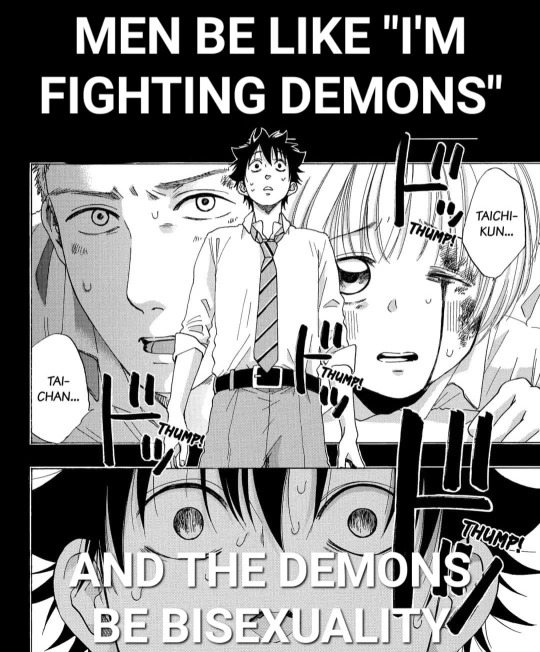
Blue flag basically
#blue flag#ao no flag#touma mita#toma mita#toma blue flag#taichi ichinose#futaba kuze#anime and manga#bisexuality#Blue flag? 😏 more like blue fa- *gets shot*#but seriously#i can't stop reading it as blue fag helppp 😭😭😭#Also i recommend everyone to read it#is kinda bittersweet and even though i despise love triangles i kinda like this one#specially since i remeber something that red from overly sarcastic productions said about “true triangles”#when character A likes character B Character B likes Character C and characted C likes Character A#and that it could never be a true triangle cause one of them be gay otherwise#so the fact this one WAS a true triangle#and it explored and called out some bs about society and heteronormativity#but also subtly brought aromanticism and asexuality in a way#and a little bit of transness#but the last one is just kind of a headcanon of mine lol#Also dude if i tell you i actually screamed and was kicking my feet at the end#i did not expect it AT ALL#i feel like this one and stars align will always hold a special place in my heart now#is weird for manga to make me cry so this one kinda surprised me too#also IT HAS A HAPPY ENDING#there were some stuff that pissed me off but they were minimal#lgbtq#btw this meme is lowkey canon just so you know like i won't say spoilers but believe me when i say it's kinda canon
98 notes
·
View notes
Text
A Quick History of BL
As someone who wrote a thesis on this very subject a few years ago, here is the short version of how BL has evolved throughout the years. For the new comers ❤
a minute of silence for the original form of this post that tumblr decied to not save right after I saved it
I am going to go with a chronological approach. Unfortunately, I cannot put everything in one post so if there’s any questions about this or that aspect of the history of BL that you want to know and it’s not talked about here, you are welcome to ask me directly :)
Context and influences - Japan in the 60′s
Before the US forced Japan to open its borders to the outside world in the 1800s, homosexual practices were common place between budist monks, samurais and kabuki actors. During the Edo period (1600s to 1800s) there was a very rich amount of poetry, art, books (such as Nanshoku Okagami (The Great Mirror of Male Love) by Ihara Saikaku) and codes of conduct about how to have a good master/aprentice relationship, kinda like the greeks if you know what I mean. However, with the arrival of western influences, in order to become a more “civilized” country, it was all put in the closet.
Yet, in the 60′s Japan started to pick it up again through literature about young androginous beautiful boys (aka bishounen). On one hand, in 1961, the novel Koibitotachi no Mori (A Lover’s Forest) by Mari Mori was published. It tells the story of a young and beautiful 19 year old worker and a half french half japanese aristocrat, and their tragic romance. On the other hand, Taruho Inagaki wrote Shounen ai no Bigaku (The esthetics of boy-love), an essay on aesthetic eroticism (of which he wrote a lot of). All this was know as Tanbi (lit. aesthetic) literature. It generally refered to literature with implied homosexuality and homoeroticism such as works by Oscar Wilde, Jean Cocteau, etc. And of course, Mori and Inagaki.
In chinese tanbi is read as danmei (term used to refer to BL novels in china today, ie: The Untamed it’s all connected friends).
From the birth of Shonen Ai to Yaoi - 70′s to the late 80′s
Around the beginning of the 70′s, shoujo was being revolutionized by the Year 24 Group, a generation of women manga authors (mangaka) who started to explore new themes. Among them, their interest in tanbi gave birth to a new subgenre: Shounen ai.
Their most known manga were:
Kaze to Ki no Uta (The Ballad of the Wind and Trees) by Keiko Takemiya, and Toma no Shinzo (The Heart of Thomas) by Moto Hagio
Their stories are characterized by having suffering eurpoean bishounen in boarding schools, living an idealized perfect love (meaning passionate) that, despite the tragic end of one of them, lives forever in the other.
As this genre starts getting popular, more and more fans of these stories start making their own self published manga, aka doujinshi, of the genre. It is around this time that the term Yaoi is coined. Meaning “YAma nashi, Ochi nashi, Imi nashi” (no climax, no fall, no meaning). Basically PWP fanfiction, for the most part. Doujinshis could be considered an equivalent of fanfiction in manga form. It is also here that the term Fujoshi (aka Rotten Girl, for liking rotten things) starts being used to refer to women readers of yaoi.
With this rise in popularity come the start of the commercialization of the genre. Which meant the publication of magazines dedicated solely to yaoi/shonen ai/BL. The most popular yaoi manga magazine at the time was June. The common trait of their stories being the therapeutic power of the love between the mains. The traumatized character would heal throught this newfound love.
Most of the stories at this time happened in the West (Europe or the States) as the exploration of these dark themes intertwined with homosexual romance and homoeroticism still feel safer to explore as a foreign concept. One example would be Banana Fish (1985).
Commercialization and Yaoi Ronso - 90′s
As more publishing houses pick the genre up, the term Boys Love is used to include every type of manga about homosexuality made for women.
The increasing amount of BL series sees a changes in its themes:
the start of the “gay for you” trope where one mantains their heterosexuality despite being in a homsexual relationship,
the uke/seme dynamic (mirroring hetero realtionships) also relating to physical appearence (one being more feminine, the other being more masculine),
the use of rape as an act love (sexual violence has always been present but here it becomes a staple),
anal sex as the only type of sex,
older and more masculine men start to appear
they now happen in Japan
Good examples of the presence of these themes in manga are Gravitation (1996) or Yatteranneeze (1995).
However in 1992, Masaki Sato (a gay activist/drag queen) wrote a letter in a small scale feminist magazine attacking yaoi and pointing out how it “represented a kind of misappropriation or distortion of gay life that impacted negatively upon Japanese gay men”. The female readers of yaoi responded, defending the genre as a means to escape gender roles and explore sexual themes that was never meant to represent the realities of gay men. This is know as the Yaoi Ronso (Yaoi Debates).
The debate ended with both sides understanding more of each other, with mangakas starting to include queer views in their works. It also started the academic reasearch of BL.
Yet, it is a debate that has been restarted more than once, as it is still relevant despite the evolution of the genre.
more on this on another post
Globalization and coining of BL - 2000′s
By the beginning of the 2000s BL is being sold all over the world (like all manga), and has become a stable industry. We could say it has finally become it’s own genre.
Some of the most well known manga series, to us (in the west), of the time are:
Junjou Romantica 2002 Koi Suru Boukun 2004 Love Pistols 2004 Haru wo Daiteita 1999
all of these have anime adaptations for the curious ones
We also start seeing short anime adaptations or special episodes of the most popular series, with questionable themes, such as: adoptive father x adoptive son (Papa to Kiss in the Dark 2005), father x son’s friend (Kirepapa 2008), etc...
However the themes remain more or less the same. Junjou Romantica’s love story starts with a non-con sex scene by the older one (masc, seme) to the younger one (more feminine, uke) addressed years later in the manga btw. Koi Suru Boukun’s love story is triggered by aphrodisiacs and rape. They’re still very present in the stories but slowly going away. A mangaka that represents this era could be Natsume Isaku (Candy Color Paradox 2010).
Change is slow in Japan. Even though the voices of LGBT+ people started to be taken into account in the genre it is not until later that we see it reflect in the mangas themselves. However, we can already see the start of this in Doukyusei (Classmates) (2006) by Asumiko Nakamura. Also Kinou Nani Tabeta? (2007) which is actually part of a more mature genre: Seinen.
It is my personal (subjective) theory that the BL of this era was the one that got popular outside of Japan, which is why we see lots of references to the themes, tropes and dynamics of this time in today’s BL series.
The LGBTzation of BL and the rise of webtoons - 2010′s to 2020′s
Slowly but surely LGBT characters and themes enter the scene of BL. Existing simultaneously with the previous tropes and themes, we start seeing a shift in these stories. We now see:
characters that identify as gay or some type of queer
discussions about homophobia
more mature themes about life and romance
At the same time as we get the usual love stories with the usual themes, a new trend starts to take over. And we get simultaneously, cute, sometimes questionable but light love stories:
Love Stage 2010 Ashita wa Docchi da! 2011 Kieta Hatsukoi 2019
More profound stories and darker or more complex themes:
Blue Sky Complex 2013 Saezuru Tori wa Habatakanai 2011 (mafias) Given 2013 (suicide) Hidamari ga Kikoeru 2013 (deafness)
And others that adress the queer experience in a more mature way (which might actually fall into the Seinen genre)
Itoshi no Nekokke 2010 (slice of life, queer characters) Smells like Green Spirit 2011 (two ways to deal with a homphobic society) Strange 2014 (relationships between men) Shimanami Tasogare 2015 (an LGBT group helps a closeted gay) Old Fashioned Cupcake 2019 (you know this one 😉) Bokura no Micro na Shuumatsu 2020 (the end of the world)
As queer stories are explored, BL mangakas and mangakas from other genres start to consider more stories about queer people such as the Josei Genderless Danshi ni Aisaretemasu (My Androgynous Boyfriend) (2018) by Tamekou, or the Shoujo Goukon ni Itarra Onna ga Inakatta Hanashi (The story of when I went to a mixer and there were no women) (2021) by Nana Aokawa.
Still, we can see two realities live side by side. Doukyuusei gets adapted into an impactful animated movie in 2016, meanwhile Banana Fish gets an anime adaptation that keeps the homoeroticism but not the homosexuality.
For those who might be interested. Here are some of the authors that represent the first half of this era, where they start to include newer points of view:
Scarlet Beriko, HAYAKAWA Nojiko, KURAHASHI Tomo, OGERETSU Tanaka, Harada, KII Kanna (Stranger by the Sea), etc...
And authors that while keeping classical themes break the stereotypes in a subtle manner:
CTK, ZAKK, Jyanome, Cocomi, Hidebu Takahashi, SUZUMARU Minta, etc...
Mangakas also no longer stick to one genre only. They explore whichever of them they want, from BL to Seinen to others.
ie: Tamekou,
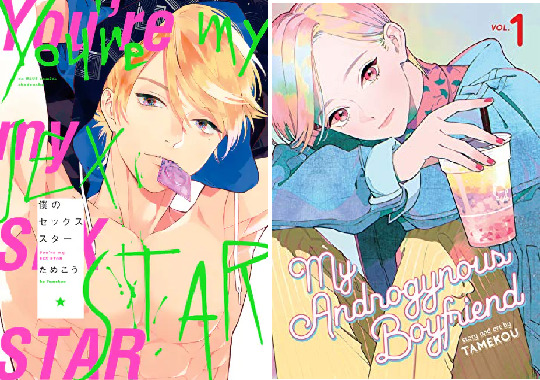
or Asumiko Nakamura

The curious case of Webtoons
With the digitalization of mangas, throught Renta and Lehzin, it has become easier (and more expensive) to access these stories. Korea makes and appearence with their webtoons. Through the lack of piracy protections and the majority of them being digital, manhwa (korean webtoons) sees a rise in popularity. Through the digital medium the influencee can be the influencer.
However, like many other East Asian countries they have consumed BL, without hearing about the conversations about BL. So they end up mantaining the older themes and stereotypes that newer BL is trying to leave behind. Therefore, we end up with a mix of old and new, ie:
Killing Stalking 2016 Cherry Blossoms After Winter 2017 Painter of The Night 2019
Additionally, it is also thanks to the easy access to internet that Omegaverse, with its higher dramatic stakes (that parallel hetero dynamics), enters the mangasphere in 2016. It has grown in popularity ever since.
With the Thai BL Boom of 2020, Japan rediscovers its own BL market and starts investing in it more. Which is why we get live action adaptations of BL manga that was popular years ago (Candy Color Paradox was a manga from 2010), the more recent ones (The End of the World With You) or new anime adaptations (Saezuru Tori wa Habatakanai in 2020).
more on this in my japanese live action BL post
What has it become now? is it BL? ML? or Seinen? Or is it all just gay manga?
It is clear that Shoujo manga (with BL, Josei and Seinen) is exploring queer themes such as gender and sexuality more and more. Japan is interested in this conversation, not only in manga (Genderless fashion). Which brings up the current question in BL studies: Does it make sense to keep these categories?
As a response to BL, ML (Male Love), which is made by gay men for gay men, started happening (around the 70s too). And Bara (gay manga porn) in response to Yaoi. However both gay men and women read BL and ML. We also see other themes being explored through BL, such as friendship (in BL Metamorphose), food (in Kinou Nani Tabeta), male relationships of all kinds (in Strange), and different queer views on life and its challenges (in Shimanami Tasogare). More and more what is LGBT and what is BL is merging, the line is blurred.
Conclusion
BL has been in my life for longer than it hasn't. It is through shoujo and BL that I have come to understand people and romance.
It is flawed, like everything else this life, but it's flourishing in many ways.
The genre feels old and new at the same time.
We can still find shounen ai/tanbi elements in more modern manga (All About J). Or the gay for you in a new light (Itoshi no Nekkoke). Or more educational manga on queer issues (My Brother’s Husband by Gengoroh Tagame). BL has around 50 years of existence but it is also being born anew in Thailand and Korea.
BL manga will continue to evolve in acordance to Japanese tastes, as it is still a local market. Hopefully the korean webtoons that get popular will be the more daring ones in their themes. Who knows where it will go from here? The only thing we know for sure is that it will continue to change. Isn't it exciting?
A post on the evolution of live action BL in Japan is coming, to complement this post. As well as a more detailed explanation of the Yaoi Debates and gay manga.
#history of bl#bl post series#I feel like I left too much stuff out#I hope it makes sense#honestly I would really recommend reading some of those manga#they're super interesting#soon it'll be 20 years since I started reading BL#my gosh#if theres anything anyone wants to know more about#I'd love to write more :)#yaoi manga#bl manga
741 notes
·
View notes
Text

Anne from management :)
Weekly reminder to read/watch Helck ( ep 3 should be out soon enough!)
#fanart#myart#digital fanart#helck#helck anime#Vamirio#Vermilio#vamirio helck#Helck manga#i love them#i recommend the manga more#good non-isekai fantasy story#anne#anne from management#helck ep 2#helck ep 3#anne helck
5 notes
·
View notes
Text

A Secret Santa gift for Zabb (@ /// abc10waffles) on twitter!! Toji and Zangi happen upon some very special kitties!! 😺 🎄 💝 🎁
#my art#v#ultimate exorcist kiyoshi#series i haven't drawn for before#but I read with KB friends! Super charming and totally recommend if you want something a bit more old school manga.
44 notes
·
View notes
Note
You're always so on point with your posts. On that note, it made me realize that; Considering the themes of desires in DunMeshi. It's also to say that what you think you want isn't what you actually want.
Like, Marcille thinks she wants the handsome prince from the novels she reads... But what she actually wants is someone maybe more like her father who she admired so much. Kind, virtuous, caring to a fault, a family man. Things she later finds in Chilchuck.
Because as traumatizing as it was to see her mother's spiral after her father's death; Her memories of her father itself are some of the most important to her. And it fits with her pursuit to increase her loved ones' lives, because she does want what her mother and father had.
Sipping. I do go over ‘what you think you want vs what you actually want + what you need’ in my (upcoming) Marcille & Chil arc analysis ;) It’s a part of Dunmeshi that I really like and is super fascinating, I’d honestly like to make an analysis-post on the topic: all the different threads and characters in canon that reflect that, desires vs wants and themes of idealization in Dunmeshi, but it’s one of those things that’s just so huge to make. See this is the freaking problem with doing Dunmeshi meta you start talking about the themes or a narrative and everything is so interwoven you get distracted with tangents BUT IT’S ALL COMPELLING AND RELEVANT
I know that’s something laimar does a lot too, the dad thing, with Marcille in a post-canon comic knitting beside him paralleling her parents and whatnot. I don’t know if I fully agree on the angle but there’s definitely stuff to dig at there…
Like I know that I’d like to analyze Marcille’s succubus more, it comes up in my analysis draft but it’s not the point I’m trying to make there so I focus on other stuff but… I always saw the focus of Marcille’s succubus as that she sought out an emotional connection most of all, it’s romantic and courtly in nature but more importantly there’s personality and behavior there and it’s a character she already loves and knows deeply from having read the series, so it’s not like Chil where it’s just a pretty face whose identity doesn’t matter. A friend of mine though, @room-surprise, goes with the angle that it shows she isn’t ready for a relationship and that the appeal is very self-centered, and I def think compelling points are made…
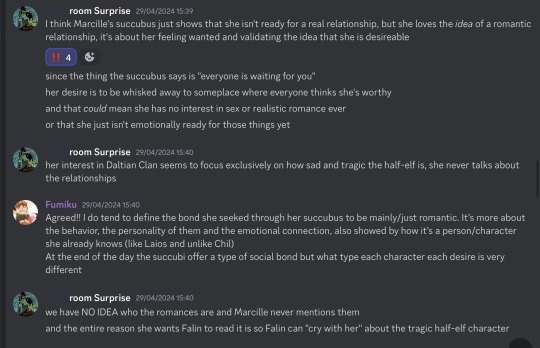
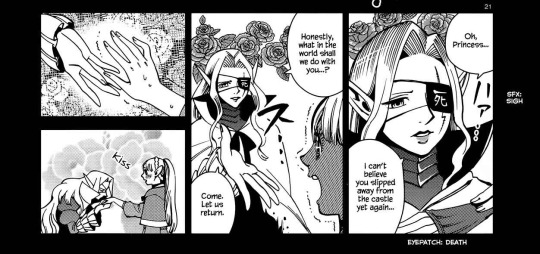
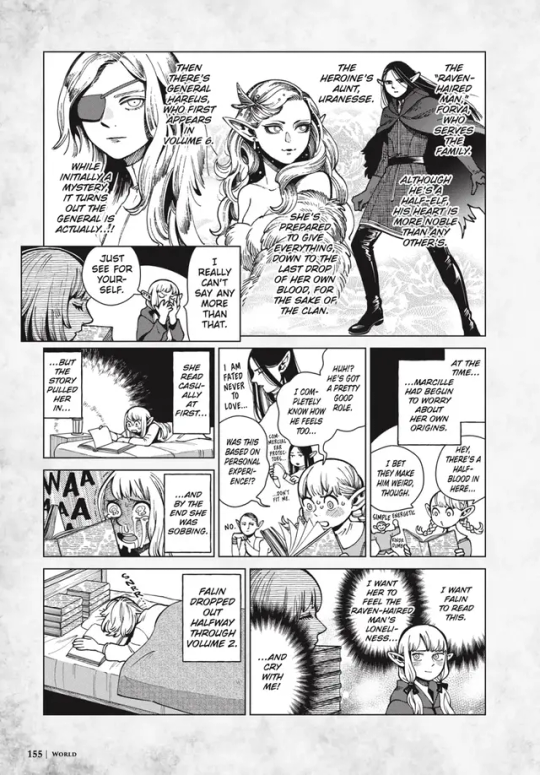
Point I was trying to make, the succubus is definitely at the crux of figuring what it is Marcille wants and craves in someone I’d say, where she’s emotionally at wether consciously or subconsciously, or how she sees herself being involved in romance at least… It’s true Marcille is enthusiastic about romance, but always someone else’s, never hers, and she seems unwilling to examine her own relationships with people. She oversteps boundaries either obliviously or carelessly and doesn’t like change…
And then there’s how complex people’s relationship to fiction can be on top of that and graaaaah
Edit in bc I forgot I wanted to mention this like an idiot: OH and I do think the Daltian Clan serves a role in the general tapestry of Dunmeshi as well, sometimes in in depth ways that Room-Surprise will tackle in their research paper way better than me I’m sure. My understanding of the importance of general Hagreus in a more general narrative sense is that he reinforces the theme of idealization/fantasy vs reality that’s super present through the manga. Beyond just Marcille’s arc and his importance to her he’s designed uncannily close to Mithrun, it parallels real elves and their very flawed military system and the broken people it cultivates vs the romanticized elves put on an aesthetic pedestral in novels, especially considering it’s "general" Hareus
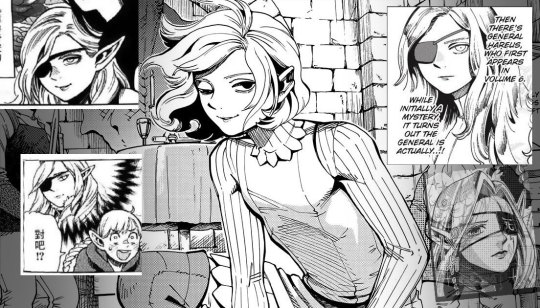
To give some previews of the analysis wip: Thus the succubus targets Marcille’s wish for a perfect knight who could cherish her forevermore, someone safe and known and fantastical, just hers in a way, free to see and construct however she wants because he’s a character to interpret Dungeon Meshi is in part about resisting desires, the irrational cravings, mostly through the character of the demon. I mentioned needs earlier, and to ideals vs wants we also add vs needs, both emotional and physical. And needs alongside wants are what Dungeon Meshi wishes to promote for a healthier person. Dungeon Meshi illustrates very well with the dungeon lords that you can be a slave to your desires. Dunmeshi prones the important of balance for both a healthy body and a healthy mind, and the arc of optimism vs pessimism with Marcille & Chilchuck is one such case <3
Ouuuugh how flawed relationships with flawed people can still be made into somehing good and healthy that make the world brighter…
We’ve gone far from the topic of how her family shaped what she seeks in relationships haha, I think you put it well already though I don’t have much to add on that front Edit in 2: SIKE! I’ll add that there’s an interesting thread in the manga of Marcille maturing and becoming more like her mother, which would be interesting and fun to pair with the fatherhood of Chil. Because Marcille is sometimes a mother figure as well: she’s the mom friend. I go over it here, and since when I made that post I’ve seen more interesting analysis on the topic too, like noticing she hides behind her mother’s portrait in the nightmare chapter, perhaps the inspiration behind her more mature reserved academic persona she sometimes has. Her parents are def important to her so it’s interesting to see how all the dynamics and her own psychology fit into that….
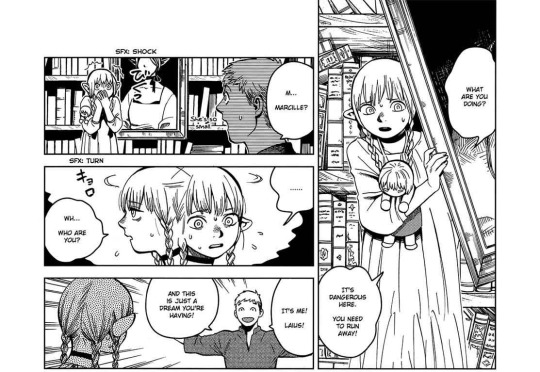
But yeah I think what she (thinks she) wants out of romance has a lot of layers, both conscious and subconscious… I haven’t gone into the bigger picture of how fiction affects her relationships here but it’s the central topic of my Marcille & Chil arc analysis so. She idealizes the trope of the prince charming and finds it attractive but is that what she would actually latch onto… Is it fully superficial, is it more about herself than it is about her potential partner... Is it mainly because she wants to get validation, from being special that she typically gets from high academic performance… We do see she can be rather insecure and worried about others’ perspective of her, that they think she’s not useful or capable enough, especially in the mandrake chapter… Unconditional love perhaps
What is your emotional landscape Marcille. How emotionally intelligent are you. I don’t think she knows what she wants romantically. I think she has a job so she don’t really care about that rn I’m just not sure if we can figure out what she ~actually~ wants on her behalf that might be too many levels of interpretation but idk idk, thinking on it still
#Ask#marchil#Spoilers#Dungeon meshi manga spoilers#As an aroace obviously obsessed with shipping. Me 🤝 Marcille very possibly being uncomfortable at the thought of being in a relationship#Considering her fear of loss + loss of control at categorizing her relationships and the Falin bath scene analysis yk the one#How she pushes herself to think of Falin as a kid still bc it’s more digestible and less scary. Bc change and aging and vulnerability#Like she could totally be super on board to get into a romance at a snap of fingers buuut there’s enough material where also could be not#The post ended up not being very marchil but yeah… in the end i ship it bc i think chil is both what she wants and needs in a lover#It’s ok even if they don’t do much pda she’ll just romanticize that it makes it more special#Marcille donato#Meta#Btw big recommend the youtube video essay on OFMD season 2 by The Sin Squad… Makes me think about Marcille v much
82 notes
·
View notes
Text
I'm so in love with this kind of characters

If anyone has a recommendation, it could be anime or manga and whatever gender honestly. I love my robot and Internet-related cuties <3
(I don't know the creator of the fanart, pls tell me and I will give them credit. I love it so much, it's so cute)
#hatsune miku#vocaloid#chobits#chobits chii#lain iwakura#serial experiments lain#gintama#anime and manga#anime fanart#robots#cute girl#anime character#otakucore#anime#cute character#collage#i love my girls#otakuworld#vocaloid miku#pls pls pls#manga recommendation#anime recommendation#aroace#robot lover#i need more
25 notes
·
View notes
Text

Little MHA setup of mine フッ(⸝⸝⸝≖ᴗ≖⸝⸝)‧⁺✧*
Feels like Where's Waldo in a way if you zoom in and look hard enough (^~^;)ゞ
(I put all the Aizawa things together for organization but now it looks more like a mini shrine ┐( ^_^;)┌ )
Also I'm a bit of a scavenger and will collect anything MHA related, so that's led to me getting stuff like this lol

I love him so much, he's so scrungly (◍¯∀¯◍)
#i actually have a lot more but they're all on another shelf that's not finished yet#that shelf has a similar set up but instead of the official manga series it's the spin-offs#just need to get more things to fill it up (;^ω^)#lots of little things hidden in this - i recommend looking through it for a second (๑¯◡¯๑)#my hero academia#boku no hero academia#bnha#mha#aizawa shouta#shota aizawa#shouta aizawa#aizawa shota#bakugo katsuki#katsuki bakugo#izuku midoriya#midoriya izuku#deku#hitoshi shinso#hitoshi shinsou#shinso hitoshi#shinsou hitoshi#toshinori yagi#yagi toshinori#all might#kurogiri#tomura shigaraki#shigaraki tomura#class 1a#🍥#🪪
43 notes
·
View notes
Text
top 10 manga i read in 2024:
(please note these are not necessarily published in 2024. just things i read or picked up this year)
the fable / ザ・ファブル by minami katsuhisa (seinen / hitman, yakuza, action, comedy / complete) a famed hitman must lay low under the care of a local yakuza group in osaka for a year, blending into a society he is deeply unfamiliar with. some of the most thoughtful and funniest character writing i've ever read.
adults' picture book / otona no zukan kaiteiban / おとなのず��ん改訂版 by itoi kei (seinen / childcare, drama / complete) when his late best friend (and maybe more) passes away, an adult comics mangaka must get his act together to take care of his orphaned daughter, even enlisting the help of a local tax accountant to his new odd family. i think this is one of those series that caught me at the exact right moment. you too can read vol 1 as a creative in your late 20s to max out emotional damage.
sketchy / スケッチー by maki hirochi (seinen / sports, slice of life / complete) burnt out and feeling lost, ako stumbles into a group of female skateboarders one night on the way home — invigorated with hope and excitement, she, along with a great cast of women, take up the sport too. absolutely delightful and inspiring, through and through.
colette decides to die / colette wa shinu koto ni shita / コレットは死ぬことにした by yukimura alto (shoujo / fantasy, mythology, romance / complete) (tw: suicide) a village doctor, desperate for a break from overwork, jumps into a well. when she arrives in the land of the dead, she meets its king -- hades -- who is sick and needs her care. a very unique take on greek myth with wonderful slowburn romance between the leads.
do not call it mystery / mystery to iu nakare / ミステリと言う勿れ by tamura yumi (josei / detective, mystery, drama / ongoing) totonou kunou is arrested for the murder of a classmate he doesn't know. after he successfully deduces each cop's backstory while in custody, the police consult his detective skills for other cases, including his own. if you liked basara or seven seeds, i probably don't need to sell this to you.
smoking behind the supermarket with you / super no ura de yani suu futaru / スーパーの裏でヤニ吸うふたり by jinushi (web comic / slice of life, romance / ongoing) overworked and stressed out, sasaki regularly visits his local supermarket for one reason only: the cute cashier yamada. on one visit, he doesn't see her. disappointed, he takes a smoke break behind the store and encounters tayama, a mischievous coworker who seems oddly familiar. a friendship between the two grows with every shared cigarette. if you liked wotakoi but want something more down to earth, this is for you.
gazing at the star next door / tonari no stella / 隣のステラ by ammitsu (shoujo / romance / ongoing) chiaki reckons with her feelings for her next door neighbor and best friend subaru, who's quickly rising through the ranks to become the most popular actor in japan. read this for a classic, butterflies-in-your-stomach shoujo romance feeling.
orb: on the movements of the earth / chi. chikyuu no undou ni tsuite / チ。―地球の運動について― by uoto (seinen / historical, drama / complete) this manga follows several generations in a fictional retelling of the discovery of heliocentrism in the solar system. when claiming that the earth revolves around the sun will get you killed for heresy, these figures must work together in secret, so that church's terrifying inquisitors cannot find them. this fucks, and the anime fucks even harder.
a condition called love / hananoi-kun to koi no yomai / 花野井くんと恋の病 by morino megumi (shoujo / romance, drama / ongoing) a girl who struggles to understand romance and a boy with debilitating abandonment issues enter a trial relationship after a kind act makes him fall in "love." a tough read at times, but to me, this is a welcome commentary on the "obsessive male lead" trope in romance manga.
lost lad london / ロスト・ラッド・ロンドン by shinya shima (seinen / mystery, drama / complete) a young part-time worker, al adley, is framed in the fatal stabbing of london's mayor. when by-the-book detective ellis gives him the benefit of the doubt, the two work together evade arrest to unravel the murder -- and the reason al has been targeted. short (3 vols) and underrated with a unique and delightful art style and some keen social commentary.
#ani.txt#manga recs#manga recommendation#2024 manga recs#manga talk#one post about manga per year to justify my username#i cannot emphasize enough just how much i enjoyed the fable. oh my god. i wish i'd read it sooner#i might make a top 10 ongoing if anyone is interested in that. need to think about it more first#i didn't watch a ton of anime this year so i won't make a full list but look back dandadan and dead dead demons' were probably 1 2 and 3?#long post
17 notes
·
View notes